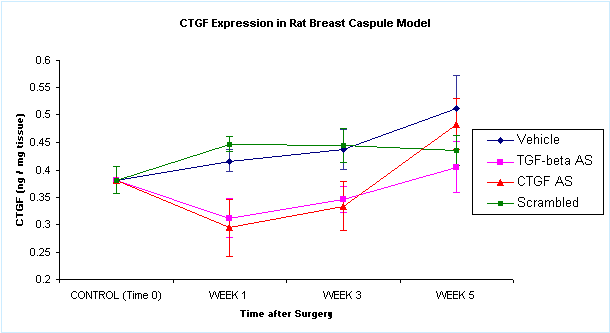Sunday, November 3, 2002 - 10:45 AM
748
Role of CTGF in Breast Implant Elastomer Capsular Formation
Background:
Connective tissue growth factor (CTGF) was identified in 1991 in cultures of human vascular endothelial cells. Up to that time, transforming growth factor-b (TGF-b) was thought to be the sole mediator in multiple fibrotic disorders such as in Dupuytren's contractures and in pulmonary fibrosis. Recently, it has been demonstrated that CTGF stimulates wound contraction and fibrosis and acts as a downstream mediator of TGF-b.
Purpose:
1)To assess the role of CTGF in breast implant elastomer capsule formation over time.
2)To determine the effect of TGF-b and CTGF anti-sense (AS) oligonucleotides on capsular formation.
Method:
Fifteen Sprague-Dawley rats were randomly assigned to treatment (n=12) and control (n=3) groups. Four pockets 2 x 2 cm were created on the dorsum deep to the panniculus carnosus in each rat; and a 1 x 1 cm smooth breast implant elastomer was placed. Each rat in the treatment group received 1 ml of: vehicle, AS TGF-b, AS CTGF, and AS scramble (control for oligonucleotide toxicity). Control rats received 1 ml of vehicle or saline in each of the pockets. At weeks 1, 3, and 5, four treatment rats and one control rat were randomly selected and sacrificed. Tissue blocks including elastomer were harvested for determination of CTGF levels using the ELISA technique. Tissue was sent for H&E slides to evaluate capsule formation.
Results:
Levels of CTGF in capsular tissues treated with vehicle or AS-scrambled were similar and progressively increased in both tissues on weeks 1, 3 and 5, compared to normal skin, with levels in vehicle-treated tissues approximately a 40% higher on week 5 than normal skin (p=0.05). At weeks 1 and 3 after surgery, levels of CTGF were suppressed in capsules treated with AS-CTGF and AS-TGF-b compared to normal skin and to tissues treated with vehicle or AS-scrambled (p=0.002). On week 5, levels of CTGF in tissues treated with AS-CTGF or AS-TGF-b were similar to levels in normal skin. Histological analysis revealed reduced capsular formation in samples treated with AS-CTGF or AS TGF-b compared with samples treated with vehicle or AS-scrambled.
Conclusions:
A single, local treatment with AS-CTGF or AS-TGF-b at the time of surgery reduced CTGF levels in tissues and correlated with reduced capsular formation in a rat model. These data suggest a new therapeutic strategy to reduce early capsular formation based on local application of antisense oligonucleotides targeting CTGF and TGF-b.

View Synopsis (.doc format, 110.0 kb)
